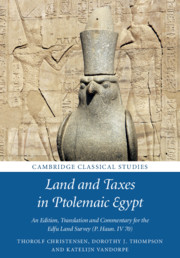 Land and Taxes in Ptolemaic Egypt
Land and Taxes in Ptolemaic Egypt from Introduction
Published online by Cambridge University Press: 17 October 2017
The Edfu land survey in context
Through most of its long history Egypt's prosperity and wealth has derived from the Delta and the fertile valley of the river Nile. Until the completion of the Aswan dam in the first years of the twentieth century the annual Nile flood covered the land, bringing silt and minerals to enrich the agricultural land for cultivation once the flood subsided. Whoever ruled the country depended on the success of Egypt's agriculture, from the sale and taxation of crops grown in the irrigation basins and in fields along the river edge. For any administrative regime, control of land and the revenue derived from it was crucial.
This book provides a glimpse into how, and with what success, this process was managed at a particular moment of time – the late second century BC – when Egypt was ruled by an immigrant dynasty of Greek-speaking pharaohs from Macedon whose kings all took the name of Ptolemy. The focus of our study is the administrative area or ‘nome’ that was centred on the city of Apollonopolis Magna, modern Edfu – the Apollonopolite or Edfu nome (see Map, p. xviii).
Administratively as well as geographically, this nome formed part of the broader area known as the Thebaid. Located some 745 km south of Cairo and 83 km south of Luxor (Thebes), the city of Edfu itself lay perched on a sandstone ridge – a gezira or turtleback – on the west bank of the Nile at around the halfway point of the nome. Best known to modern travellers for its impressive temple of Horus, Edfu stood above the flood plain on a bend in the river. The city thus enjoyed both natural protection when the annual flood arrived in late summer and considerable cultivable land in its immediate vicinity. The flood plain surrounding the city extended 6 km across at its broadest point and stretched along the western bank of the Nile some 13 km north to Sacayda and 12 km south to Nag el Hassaya, the site of Edfu's cemetery in the Ptolemaic period. This plain provided some of the most fertile basins of the nome and a network of canals facilitated irrigation.
To save this book to your Kindle, first ensure [email protected] is added to your Approved Personal Document E-mail List under your Personal Document Settings on the Manage Your Content and Devices page of your Amazon account. Then enter the ‘name’ part of your Kindle email address below. Find out more about saving to your Kindle.
Note you can select to save to either the @free.kindle.com or @kindle.com variations. ‘@free.kindle.com’ emails are free but can only be saved to your device when it is connected to wi-fi. ‘@kindle.com’ emails can be delivered even when you are not connected to wi-fi, but note that service fees apply.
Find out more about the Kindle Personal Document Service.
To save content items to your account, please confirm that you agree to abide by our usage policies. If this is the first time you use this feature, you will be asked to authorise Cambridge Core to connect with your account. Find out more about saving content to Dropbox.
To save content items to your account, please confirm that you agree to abide by our usage policies. If this is the first time you use this feature, you will be asked to authorise Cambridge Core to connect with your account. Find out more about saving content to Google Drive.